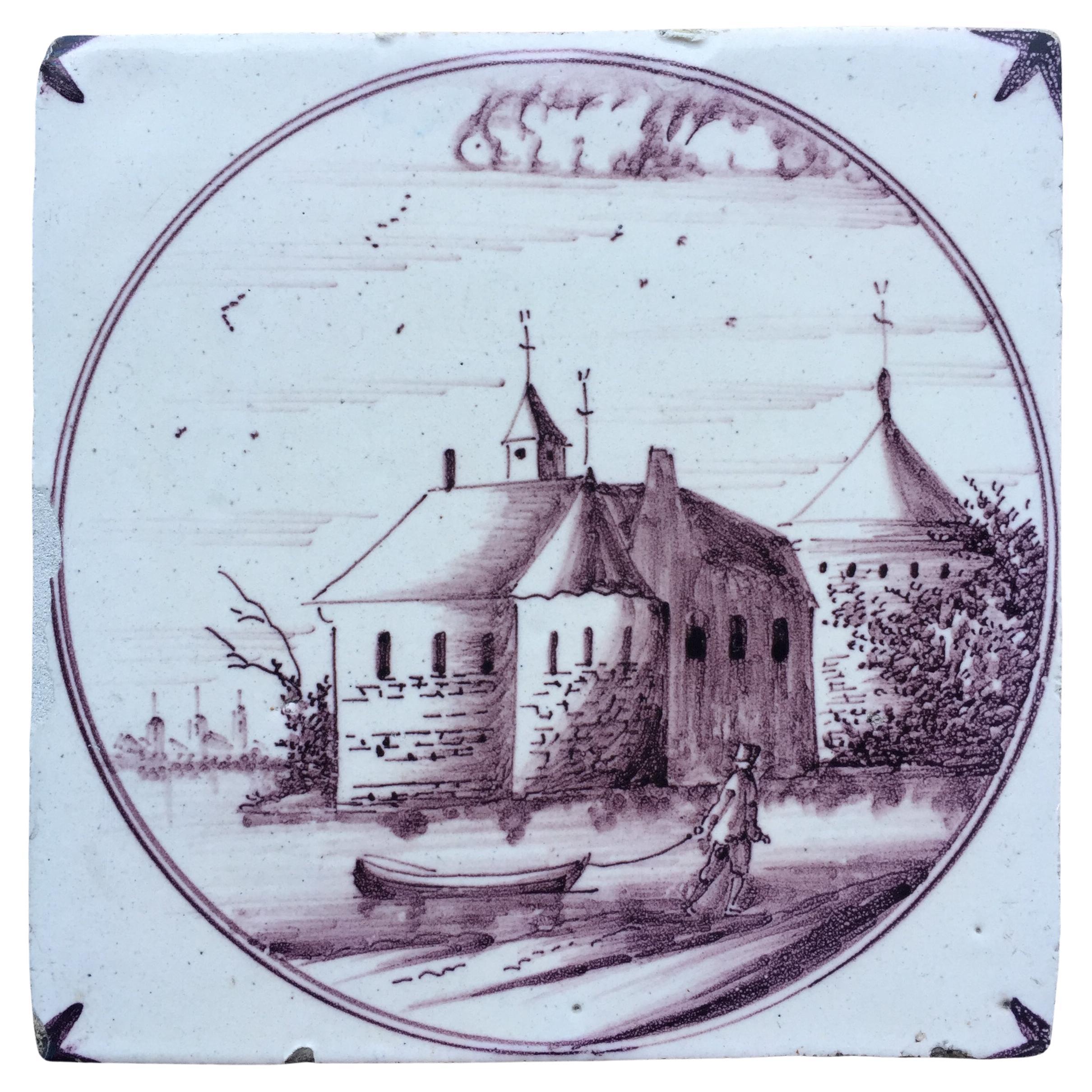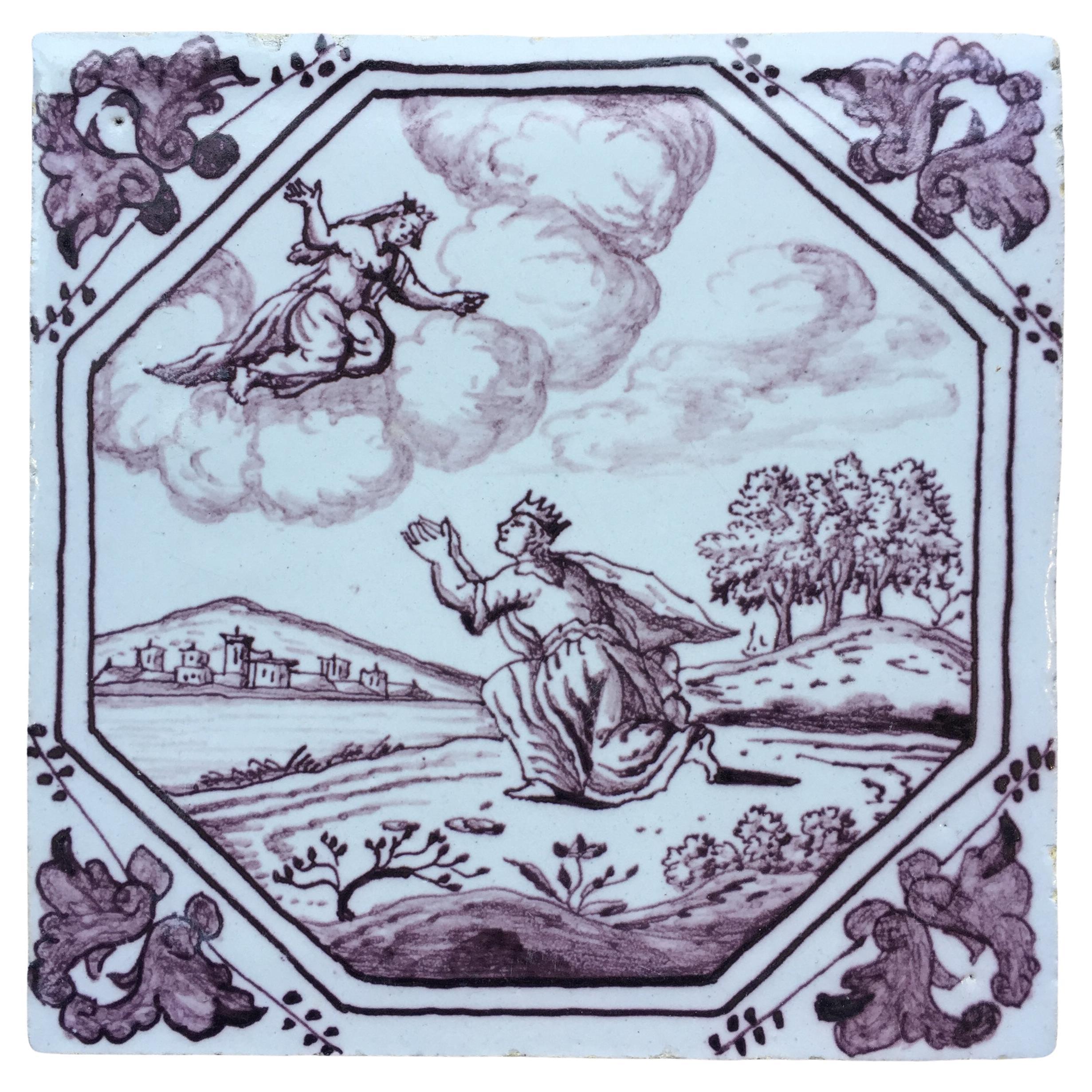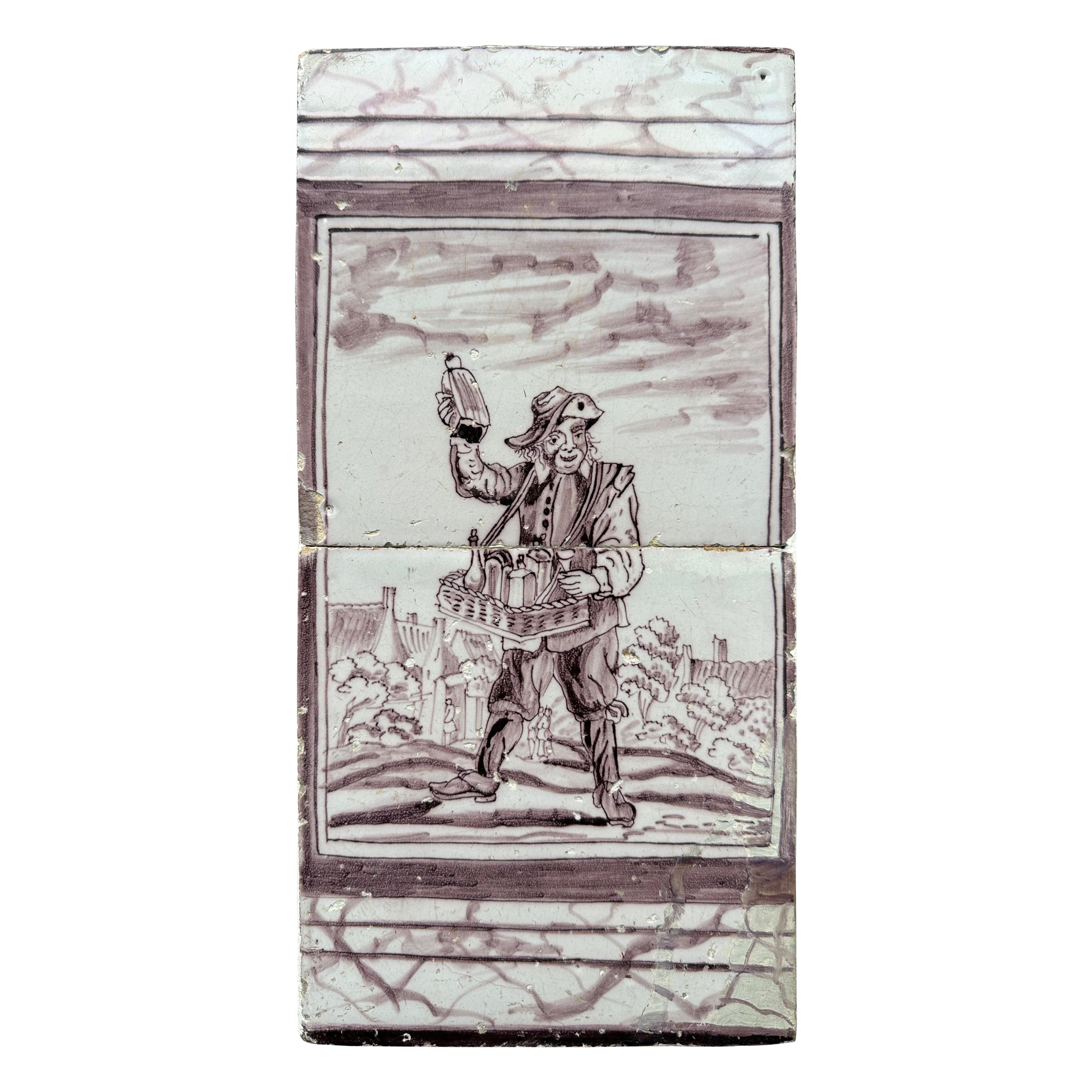Items Similar to 18th century mythological Dutch Delft tile with decoration of Vertumnis & Pomona
Want more images or videos?
Request additional images or videos from the seller
1 of 6
18th century mythological Dutch Delft tile with decoration of Vertumnis & Pomona
About the Item
Rotterdam
Ca. 1740
Atelier Hendrick Schut
A very fine painted tile with mythological decoration after Ovidius.
What is special is that this tile has a decoration from Roman mythology, which is not related to the Greek, like all the other stories stories. This and the other on my listings are the only known ones depicted on tiles.
The Roman legend of Vertumnus and Pomona, Ovid 14, 622-771;
”Pomona lived in this king’s reign. No other hamadryad, of the wood nymphs of Latium, tended the gardens more skilfully or was more devoted to the orchards’ care, hence her name. She loved the fields and the branches loaded with ripe apples, not the woods and rivers. She carried a curved pruning knife, not a javelin, with which she cut back the luxuriant growth, and lopped the branches spreading out here and there, now splitting the bark and inserting a graft, providing sap from a different stock for the nursling. She would not allow them to suffer from being parched, watering, in trickling streams, the twining tendrils of thirsty root. This was her love, and her passion, and she had no longing for desire. Still fearing boorish aggression, she enclosed herself in an orchard, and denied an entrance, and shunned men.
What did the Satyrs, fitted by their youth for dancing, not do to possess her, and the Pans with pine-wreathed horns, and Silvanus, always younger than his years, and Priapus, the god who scares off thieves, with his pruning hook or his phallus? But Vertumnus surpassed them all, even, in his love, though he was no more fortunate than them. O how often, disguised as an uncouth reaper, he would bring her a basket filled with ears of barley, and he was the perfect image of a reaper! Often he would display his forehead bound with freshly cut hay, and might seem to have been tossing the new-mown grass. Often he would be carrying an ox-goad in his stiff hand, so that you would swear he had just unyoked his weary team. Given a knife he was a dresser and pruner of vines: he would carry a ladder: you would think he’d be picking apples. He was a soldier with a sword, or a fisherman taking up his rod.
In short, by his many disguises, he frequently gained admittance, and found joy, gazing at her beauty. Once, he even covered his head with a coloured scarf, and leaning on a staff, with a wig of grey hair, imitated an old woman. He entered the well-tended garden, and admiring the fruit, said: ‘You are so much more lovely’, and gave her a few congratulatory kisses, as no true old woman would have done. He sat on the flattened grass, looking at the branches bending, weighed down with autumn fruit. There was a specimen elm opposite, covered with gleaming bunches of grapes. After he had praised it, and its companion vine, he said: ‘But if that tree stood there, unmated, without its vine, it would not be sought after for more than its leaves, and the vine also, which is joined to and rests on the elm, would lie on the ground, if it were not married to it, and leaning on it.
But you are not moved by this tree’s example, and you shun marriage, and do not care to be wed. I wish that you did! Helen would not have had more suitors to trouble her, or Hippodamia, who caused the Lapithae problems, or Penelope, wife of that Ulysses, who was delayed too long at the war. Even now a thousand men want you, and the demi-gods and the gods, and the divinities that haunt the Alban hills, though you shun them and turn away from their wooing. But if you are wise, if you want to marry well, and listen to this old woman, that loves you more than you think, more than them all, reject their vulgar offers, and choose Vertumnus to share your bed! You have my assurance as well: he is not better known to himself than he is to me: he does not wander here and there in the wide world: he lives on his own in this place: and he does not love the latest girl he has seen, as most of your suitors do.
You will be his first love, and you will be his last, and he will devote his life only to you. And then he is young, is blessed with natural charm, can take on a fitting appearance, and whatever is ordered, though you ask all, he will do. Besides, that which you love the same, those apples you cherish, he is the first to have, and with joy holds your gifts in his hand! But he does not desire now the fruit of your trees, or the sweet juice of your herbs: he desires nothing but you. Take pity on his ardour, and believe that he, who seeks you, is begging you, in person, through my mouth. Fear the vengeful gods, and Idalian Venus, who hates the hard-hearted, and Rhamnusian Nemesis, her inexorable wrath! That you may fear them more (since my long life has given me knowledge of many tales) I will tell you a story, famous through all of Cyprus, by which you might easily be swayed and softened.’
Painted after engravings of Crispijn de Passe (1602).
The tile is in a good condition, with the normal small chips at the edges according to age
- Dimensions:Height: 5.12 in (13 cm)Width: 5.12 in (13 cm)Depth: 0.32 in (8 mm)
- Materials and Techniques:
- Place of Origin:
- Period:1740-1749
- Date of Manufacture:1740
- Condition:Wear consistent with age and use. The tile is in very good condition, with the normal superficial wear and small chips according to age.
- Seller Location:AMSTERDAM, NL
- Reference Number:1stDibs: LU6389238842622
About the Seller
5.0
Vetted Seller
These experienced sellers undergo a comprehensive evaluation by our team of in-house experts.
Established in 2017
1stDibs seller since 2022
Typical response time: 1 hour
- ShippingRetrieving quote...Ships From: AMSTERDAM, Netherlands
- Return PolicyA return for this item may be initiated within 3 days of delivery.
More From This SellerView All
- 18th century mythological Dutch Delft tile with decoration of a CastleLocated in AMSTERDAM, NHThe Netherlands Amsterdam 1800 – 1825 An unusual landscape tile with the decoration of a castle at a river with in the front a man with a boat, painted within a circle. With a very ...Category
Antique 1740s Dutch Delft and Faience
MaterialsCeramic, Faience, Majolica
- 18th century mythological Dutch Delft tile with decoration of Hersillia & JunoLocated in AMSTERDAM, NHRotterdam C. 1740 Workshop of Hendrick Schut A very fine painted tile with mythological decoration after Ovidius. What is special is that this tile has a decoration from Roman mytho...Category
Antique 1740s Dutch Delft and Faience
MaterialsCeramic, Faience, Majolica
- 18th Century Dutch Delft Tile Panel with decoration of a liquor sellerLocated in AMSTERDAM, NHThe Netherlands Rotterdam Circa 1725 – 1775 A manganese tile panel of two tiles, probably the base of a pillar, with the decoration of a liquor seller, and by the look on his face h...Category
Antique Mid-18th Century Dutch Baroque Delft and Faience
MaterialsCeramic, Faience, Majolica
- 17th Century Dutch Delft Tile with Decoration of a TulipsLocated in AMSTERDAM, NHThe Netherlands Circa 1630 – 1660 A finely painted blue and white Dutch Delft tile with the decoration of two tulips. With so-called oxheads as corner decoration. The tile is in a ...Category
Antique Mid-17th Century Dutch Baroque Delft and Faience
MaterialsCeramic, Faience, Majolica
- 17th Century Dutch Delft Tile with decoration of a GoatLocated in AMSTERDAM, NHThe Netherlands Rotterdam Circa 1625 – 1650 A blue and white so-called candelabra or baluster tile with the decoration of a goat. It looks like a heavy rain cloud is on its way! Thi...Category
Antique 1630s Dutch Baroque Delft and Faience
MaterialsCeramic, Faience, Majolica
- 17th Century Dutch Delft Tile with decoration of a flamed orange tulipLocated in AMSTERDAM, NHThe Netherlands Circa 1620 – 1640 A polychrome Dutch tile with the decoration of an orange flamed tulip. This tile with a very large tulip was ...Category
Antique 1620s Dutch Baroque Delft and Faience
MaterialsCeramic, Faience, Majolica
You May Also Like
- Chinoiserie Dutch Delft Polychrome Faience Lobed Jar, 18th Century, HollandBy DelftLocated in Austin, TXA charming Dutch Delft ginger jar of lobed form, with chinoiserie design in polychrome tin glazed enamels, 18th century, Holland. The ginger jar (missing its lid), of globular fo...Category
Antique Late 18th Century Dutch Chinoiserie Delft and Faience
MaterialsEarthenware, Faience
- 18th c. Dutch Delft Lobed Sweetmeat DishLocated in Greenwich, CTAn early and rare 18th century Dutch Delft sweetmeat dish having eggyolk and soft gray-blue overall decorative design with a depiction of a lady sitting...Category
Antique 18th Century and Earlier Dutch Decorative Bowls
MaterialsCeramic
- 18th Century Dutch Polychrome Delft Baluster Form VaseLocated in Dallas, TXThis hand-painted Delft vase was produced in the Netherlands in the 1700’s. Delft is a city in the western part of the Netherlands that is world-renowned for ceramic pieces. As a home port of the Dutch East India Company, Delft was at the forefront of producing faience wares, which were influenced by imported Chinese porcelain. The prototypical Delftware has a white background with hand-painted cobalt blue imagery, though they can also be found in multi-colored or “polychrome” variations, such as ours. Our baluster form vase has a hand painted scene depicting a woman in a flowing dress walking across a field. The scene is surrounded by flowers, curled leaves, and a diapered background with flowering vine offshoots. On the opposite side of the baluster is a large flowering vine. The lid has a rural life cartouche that is painted with a scene depicting a farm overlooking a field or body of water . The handle of the lid has a similarly colored bird perched on a sinuous branch, while pecking at a berry. This particular design was seen on many delft baluster...Category
Antique 18th Century Dutch Delft and Faience
MaterialsDelft
- Dutch Delft Charger Hand Painted 18th Century Circa 1770Located in Katonah, NYThis antique Dutch Delft charger was made in the 18th century, circa 1770. It features a beautiful flower-filled garden hand painted in beautiful polychrome colors. We see a single large, bright yellow peony, other flowers painted in shades of purple, flower buds painted red, green leaves, a pierced rock painted deep cobalt blue, and the garden fence painted red and yellow. The border of the charger is decorated with a ring of flower buds in purple and red with green leaves. The overall effect is lovely! Dimensions: Diameter 12.5" Dimensions: 12.25 diameter x 1.75" tall Condition: Excellent with slight edge frits invisibly restored Price: $780 Background of Delft: The origins of Delft are found in the Middle East. Tin ash was used in a glaze for pottery as early as the 9th century in Mesopotamia. Using white glaze over a dark or buff-colored pottery body created a "canvas" on which painters could show brilliant colors that did not appear well on the earlier pottery...Category
Antique Late 18th Century Dutch Rococo Delft and Faience
MaterialsDelft
- Pair Dutch Delft Dishes Hand Painted 18th Century Celebrating the Dutch RepublicLocated in Katonah, NYThis pair of Delft dishes was hand-painted in the Netherlands in the 18th century, circa 1780. We see a lion and the motto Nu Rust ik Veilig, "Now I Rest Safe." The lion is a symbol...Category
Antique Late 18th Century Dutch Delft and Faience
MaterialsDelft
- Early 18th Century Blue and White Dutch Delft Clobbered VaseLocated in Fort Lauderdale, FLA blue and white Dutch delft vase made circa 1700, with clobbered-style polychrome enamels added in the mid-18th century. This brightly colored blue and white Dutch delft vase is a ...Category
Antique Early 18th Century Dutch Dutch Colonial Vases
MaterialsDelft, Pottery





